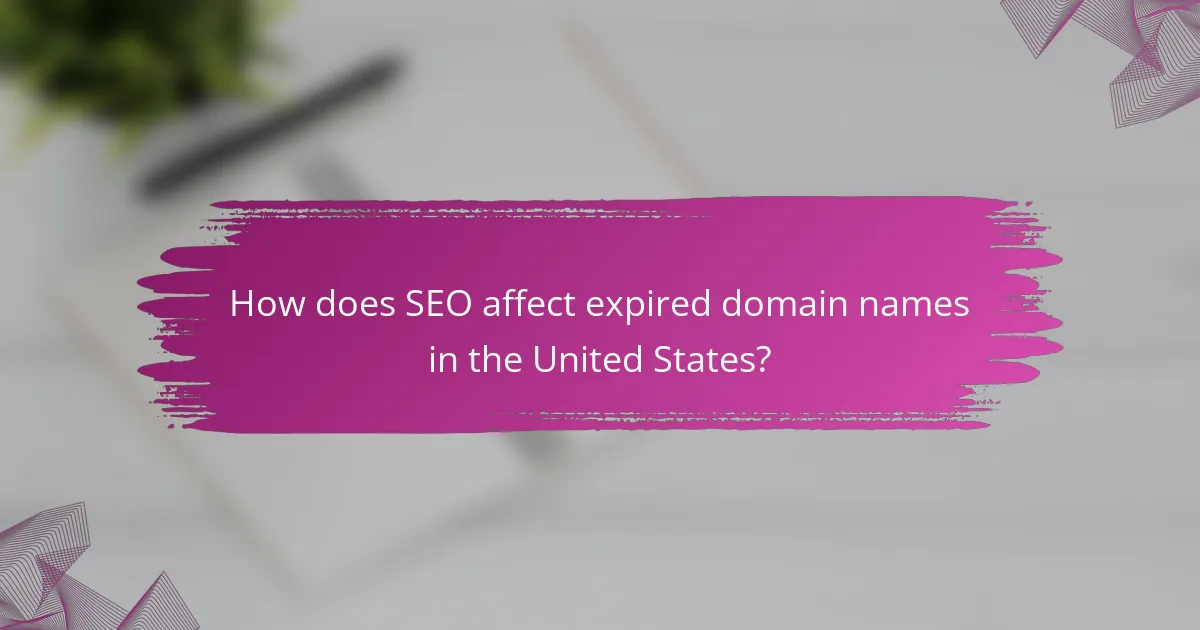The impact of SEO on expired domain names in the United States is profound, as it directly affects their visibility and credibility in search engines. Domains with a rich history of quality content and backlinks can serve as valuable assets for new websites, offering advantages such as improved link building and access to established traffic.

How does SEO affect expired domain names in the United States?
SEO significantly impacts expired domain names in the United States by influencing their visibility and credibility in search engines. When a domain has a history of quality content and backlinks, it can provide a strong foundation for new websites to build upon.
Increased authority and trust
Expired domain names often carry existing authority and trust, which can be beneficial for SEO. If the previous site had a good reputation and adhered to best practices, the new owner can leverage this trust to enhance their own site’s credibility.
To assess authority, tools like Domain Authority (DA) or Page Authority (PA) can be used. A domain with a DA score in the mid to high range is generally considered more trustworthy and can positively affect search rankings.
Potential for higher search rankings
Utilizing an expired domain name can lead to higher search rankings, especially if it has relevant keywords in its URL. Search engines often favor established domains, which can result in quicker indexing and improved visibility.
However, it’s crucial to ensure that the expired domain has not been penalized. Checking for any past penalties through Google Search Console or similar tools can help avoid future ranking issues.
Impact on backlink profile
The backlink profile of an expired domain plays a critical role in its SEO potential. A domain with a diverse and high-quality backlink profile can provide significant SEO advantages, as these links contribute to its authority.
When acquiring an expired domain, analyze its backlinks using tools like Ahrefs or Moz. Aim for domains with backlinks from reputable sources, as this can enhance the new site’s link equity and overall search performance.

What are the benefits of using expired domain names for SEO?
Using expired domain names for SEO can provide significant advantages, including improved link building, access to established traffic, and enhanced branding opportunities. These benefits can help boost a website’s visibility and authority in search engine results.
Cost-effective link building
Expired domain names often come with existing backlinks, which can save time and resources in link building. Acquiring a domain with a strong backlink profile allows you to leverage these links to enhance your SEO efforts without starting from scratch.
When considering expired domains, look for those with high domain authority and relevant backlinks. Tools like Ahrefs or Moz can help assess the quality of these links, ensuring you invest in domains that will positively impact your SEO strategy.
Established traffic and audience
Many expired domains retain some level of organic traffic, which can be redirected to your new website. This existing traffic can provide an immediate boost to your site’s visibility and engagement, making it easier to attract new visitors.
To maximize this benefit, analyze the traffic sources and demographics of the expired domain. Understanding the previous audience can help you tailor your content and marketing strategies to maintain and grow that traffic effectively.
Branding opportunities
Expired domains can offer unique branding opportunities, especially if they have a memorable name or a relevant niche. A strong domain name can enhance brand recognition and credibility, making it easier to establish your online presence.
When selecting an expired domain for branding, consider its history and reputation. Avoid domains with negative associations or penalties from search engines, as these can hinder your branding efforts. Aim for names that resonate with your target audience and reflect your business values.

What risks are associated with expired domain names?
Expired domain names can pose several risks that may affect your website’s performance and reputation. Understanding these risks is crucial for anyone considering acquiring an expired domain to ensure a successful online presence.
Penalty risks from previous owners
One significant risk associated with expired domain names is the potential for penalties imposed by search engines due to the previous owner’s activities. If the former owner engaged in black-hat SEO practices, such as keyword stuffing or cloaking, the domain may be penalized, leading to lower search rankings.
Before purchasing an expired domain, conduct a thorough review of its history using tools like Google Search Console or various SEO audit tools. Look for any penalties or warnings that could impact your site’s visibility.
Reputation management challenges
Expired domains may come with a tarnished reputation, particularly if they were previously associated with negative content or spam. This can lead to challenges in rebuilding trust with your audience and search engines alike.
To mitigate reputation issues, research the domain’s past content and its previous owners. If the domain has a negative history, consider whether you can effectively rebrand it or if starting fresh might be a better option.
Potential for spammy backlinks
Another risk is the presence of spammy backlinks that could harm your site’s authority. Expired domains often retain backlinks from low-quality or irrelevant sites, which can lead to penalties from search engines.
Utilize backlink analysis tools to evaluate the quality of links pointing to the expired domain. Disavow any harmful links before launching your site to help maintain a strong SEO profile and avoid potential penalties.

How to evaluate expired domain names for SEO?
To evaluate expired domain names for SEO, focus on key metrics such as domain authority, backlink profiles, and historical content. These factors significantly influence the potential of an expired domain to rank well in search engines and drive traffic.
Check domain authority and metrics
Domain authority (DA) is a critical metric that predicts how well a domain can rank on search engines. Use tools like Moz or Ahrefs to assess the DA, aiming for a score above 20 for better prospects. Additionally, consider other metrics like page authority, trust flow, and citation flow to get a comprehensive view of the domain’s strength.
Look for domains with a clean history and minimal spam scores. A high DA combined with low spam scores indicates a quality domain that can positively impact your SEO efforts.
Analyze backlink profile
A strong backlink profile is essential for SEO success. Use tools like SEMrush or Majestic to analyze the backlinks pointing to the expired domain. Focus on the number of referring domains, the quality of those domains, and the relevance of the backlinks to your niche.
Avoid domains with toxic backlinks, as they can harm your SEO strategy. Aim for a diverse range of high-quality backlinks from authoritative sites to maximize the domain’s potential.
Review historical content and usage
Investigating the historical content and usage of an expired domain can provide insights into its past performance. Use the Wayback Machine to view previous versions of the site and assess the type of content that was published. This can help you determine if the domain had a positive reputation and engaged audience.
Check for any penalties or negative associations that may have affected the domain’s SEO. A domain with a clean history and relevant content is more likely to succeed in your SEO efforts compared to one with a troubled past.

What tools can help in assessing expired domains?
Several tools can effectively assess expired domains, focusing on their backlink profiles, domain metrics, and historical content. Utilizing these tools can help you determine the potential value and SEO viability of an expired domain.
Ahrefs for backlink analysis
Ahrefs is a powerful tool for analyzing the backlink profile of expired domains. It provides insights into the quantity and quality of backlinks, which are crucial for SEO performance. Look for domains with a diverse range of backlinks from reputable sites, as this can indicate strong authority.
When using Ahrefs, pay attention to metrics like Domain Rating (DR) and the number of referring domains. A DR score above 30 is generally considered good, while a higher number of referring domains can suggest a more robust backlink profile.
SEMrush for domain metrics
SEMrush offers comprehensive domain metrics that can help assess the overall health of an expired domain. Key metrics include organic search traffic, keyword rankings, and the domain’s overall authority score. These factors can indicate how well the domain might perform if reactivated.
In SEMrush, focus on the organic traffic trends over time. A domain with consistent traffic before expiration may have retained some SEO value, making it a more attractive option for acquisition.
Wayback Machine for historical content
The Wayback Machine is invaluable for viewing the historical content of expired domains. By examining past versions of a site, you can understand its previous purpose and the type of content it hosted. This context can help you determine if the domain aligns with your current goals.
When using the Wayback Machine, look for domains that had relevant, high-quality content. If the previous content was well-received and aligned with your niche, it may provide a solid foundation for future development.

How to effectively utilize expired domains in SEO strategies?
Utilizing expired domains in SEO strategies can enhance your website’s authority and traffic. By acquiring domains with established backlinks and traffic, you can leverage their existing value to boost your own site’s performance.
Benefits of using expired domains
Expired domains can provide significant advantages for SEO, including improved domain authority, pre-existing backlinks, and potential traffic. These domains often come with a history that can be beneficial for search engine rankings.
For instance, a domain that previously hosted a popular blog may still attract visitors through old links. This can lead to immediate traffic gains and better search visibility, especially if the content aligns with your current offerings.
How to find quality expired domains
Finding quality expired domains involves using specialized tools and platforms that track domain history and metrics. Look for domains with high domain authority, relevant backlinks, and a clean history free of penalties.
Popular tools include Ahrefs, SEMrush, and ExpiredDomains.net, which allow you to filter domains based on specific criteria. Aim for domains that have a history of organic traffic and relevant keywords to maximize their potential.
Considerations before purchasing
Before purchasing an expired domain, assess its backlink profile and history thoroughly. Avoid domains with spammy links or those that have been penalized by search engines, as they can harm your SEO efforts.
Check for any existing brand associations that may lead to confusion or legal issues. A domain that was previously associated with a controversial site may negatively impact your brand’s reputation.
Best practices for integrating expired domains
To effectively integrate an expired domain, consider redirecting it to your main site or using it as a separate content hub. Redirecting can pass on the existing link equity, while a content hub can attract traffic and build authority.
Ensure that the content on the expired domain is relevant to your niche and aligns with your current SEO strategy. Regularly update and optimize the content to maintain its value and relevance in search engines.
